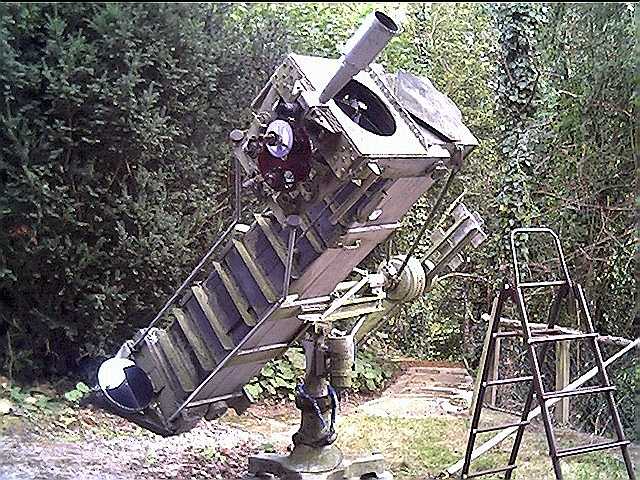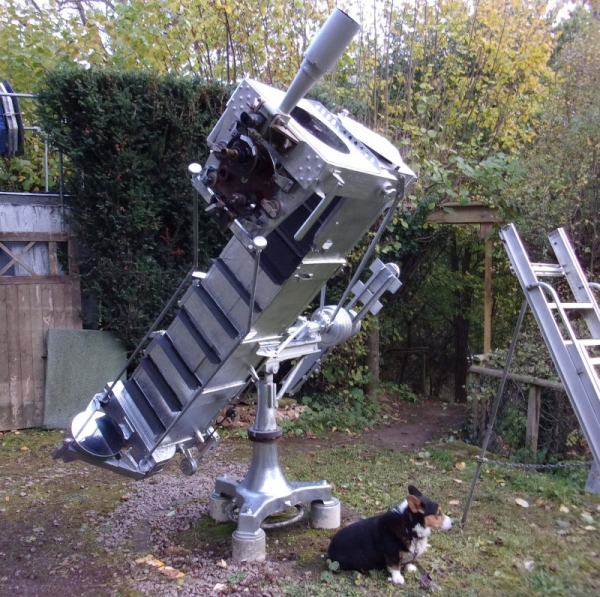The McIver Paton 12.5-inch reflector
The McIver Paton telescope is a 12.5-inch aperture f/7 Newtonian reflector on alt-azimuth mounting; the square-section wooden 'tube' is not, in fact, a telescope tube in the conventional sense at all but a box-girder for rigidity, all the optics being mounted on the outside for ease of access: the telescope is never under cover but the optics live indoors, being installed in it only at the beginning of each observing session, full set-up and optical adjustment taking no more than 10 minutes.
One of the observing books of the late R. McIver Paton F.R.C.S., F.R.A.S., member B.A.A.1942-1964. Click here or on the image to read a larger version.

The photograph above shows Mr. McIver Paton at the eyepiece of the 12½ inch telescope set up in the garden at Second Avenue, Chelmsford in the late Spring of 1949, shortly after purchase of the instrument from its creator, a Mr. King, also of Chelmsford. The 12½” has a 1908 mirror by George Calver and is believed to have been built by King in the 30’s or 40’s, incorporating mounting-components from a 19thcentury observatory equatorial. In 1967 Mr. McIver Paton gave the telescope to its present owner, who has used it extensively ever since.
The 12½-inch set up for a night’s double-star obs., Hanwell, October 2004. Despite extensive restoration in Summer 1973 and lesser repairs on several other occasions, the telescope remains to this day essentially unchanged from the 1949 photograph. It was first set up on the Hanwell site in June 1992, that marking the beginning of significant astronomy there. This is the instrument featured in Chapter 11 of ‘Observing and Measuring Visual Double Stars’ ed. R.W.Argyle 2004; in its years at Hanwell, the 12½-inch has been used to follow the motion of fast-moving binaries down to 0.2 arcseconds apparent separation and below, probably as high a resolution as ever achieved with a telescope of this size from the surface of the Earth. One such set of observations was prominently reported in the June 2005 issue of ‘Sky & Telescope’magazine, in an article ‘Porrima at Periastron’ which attracted considerable international notice. The telescope remains one of the most active at the Hanwell observatory.
Update on the 12.5-inch, August 2020.
The photo above shows the 12½-inch in November 2018 just after completion of a major restoration involving extensive structural repairs, significant upgrades such as the addition of a 5-inch f/12 Wildey refractor for use as a guidescope at visitor evenings, and a large removable weather-shield ( not shown in pic.). A variety of instrumental innovations such as a custom-made visual star-spectroscope and greatly improved provision for measuring binary stars have also been added ‘at the small end’ of the 12½-inch since 2015, more are currently in hand as of Summer 2020 and yet more planned in detail. Despite all this, the instrument is still immediately recognizable as that in the 1949 photograph, still going strong after more than 70 years.
For a recently published sample of the kind of observational work being actively pursued with this telescope at Hanwell, see:
J. Christopher Taylor, Challenging visual binaries: the case of gamma-2 Andromedae, Journal of the British Astronomical Association 130, pp. 156-167, June 2020.



